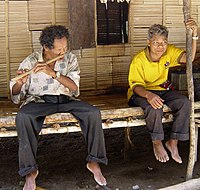Orang Asli
From Wikipedia, the free encyclopedia
 |
| Orang Asli near Cameron Highlands playing anose flute. |
| Total population |
|---|
| 149,512[1] |
| Regions with significant populations |
| Languages |
| Religion |
| Related ethnic groups |
Orang Asli (lit. "original people", "natural people" or "aboriginal people" in Malay) is a generic Malaysian
term used officially for theindigenous people of Peninsular Malaysia. Officially, there are 18 Orang Asli tribes,
categorised under three main groups according to their different languages and customs:
- Semang (or Negrito), generally confined to the northern portion of the peninsula
- Senoi, residing in the central region
- Proto-Malay (or Aboriginal Malay), in the southern region.
There is an Orang Asli museum at Gombak, about 25 km north of Kuala Lumpur.
]
History[edit]
Orang Asli kept to themselves until the first traders from India arrived in first millennium AD.[2] Living in the interior
they bartered inland products like resins, incense woods and feathers for salt, cloth and iron tools. The rise of the
Malay sultanates, coinciding with trade in Orang Asli slaves, forced the group to retreat further inland to avoid
contact with outsiders. The arrival of British colonists brought further inroads in the lives of Orang Asli. They were
During the Malayan Emergency of 1948 to 1960, the Orang Asli became a vital component of national security, as
with their help, the Malayan army was able to defeat the communist insurgents. Two administrative initiatives were
introduced to highlight the importance of Orang Asli as well to protect its identity. The initiatives were the
establishment of the Department of Aborigines in 1950, and the enactment of the Aboriginal Peoples Ordinance in
1954. After independence, the development of Orang Asli become the prime objective of the government where the
government adopted a policy in 1961 to integrate the Orang Asli into the wider Malaysian society.[3]
Within the decades of 1970s and 1980s, Malaysia was in the period of sustained growth. With development that
emphasize modernization and industrialization, new lands were developed. This development has resulted in
encroachments on Orang Asli land. In response of this encroachment, the Orang Asli mobilized themselves and
formed the Peninsular Malaysia Orang Asli Association (POASM). With this association, the Orang Asli have
become more visible and vocal. Orang Asli are now known as "Orang Kita" ('our people') since Dato' Seri Mohd.
Najib bin Tun Haji Abdul Razak introduced the "One Malaysia" concept[3]
Economy[edit]
Orang Asli living in remote forest areas engaged in some trading with the Malays, with jungle produce being
exchanged for salt, knives and metal axe-heads. There was also evidence of trade in blowpipes and blowpipe-
bamboo among certain tribes. It has also been shown that the Orang Asli have played a significant role in the
Malay Peninsula's economic history as collectors and primary traders as early as the 5th Century A.D. An early
19th century report also tells of Negritos providing forest products as tribute to the Malay chiefs of the river basins
they resided in. [1]
Demography[edit]
In 2000, the Orang Asli comprise only 0.5% of the total population in Malaysia.[2] Their population is approximately
148,000.[5] The largest group are the Senois,
constituting about 54% of the total Orang Asli population. The Proto-Malays form 43%, and the Semang forming
3%.[5]
The poverty rate among Orang Asli is 76.9%.[1] In addition to this high rate, the Statistics Department of
Malaysia has classified 35.2% of the population as being "hardcore poor". The majority of Orang Asli live in
rural areas, while a minority have moved into urban areas. In 1991, the literacy rate for the Orang Asli was
43% compared to the national rate of 86% at that time.[1] They have an average life expectancy of 53 years
(52 for male and 54 for female). A highinfant mortality rate is also evident with 51.7 deaths per 1000 births.[6]
See also: Demographics of Malaysia
Languages[edit]
The division of Orang Asli into three categories is not due to linguistic differences but is merely sociological:
linguistically they divide into two groups.
The first group speak Aslian languages, which form part of the Austroasiatic language family. These are further
divided into the Jahaic languages (North Aslian), Senoic languages,Semelaic languages (South Aslian), and Jah
Hut.[7] The languages which fall under the Jahaic language sub-group are the Che Wong, Jahai, Bateq, Kensiu,
Kintak, and Menriq languages. The Lanoh language, Temiar language, and Semai language fall into the Senoic
language sub-group. Languages that fall into the Semelaic sub-group include theSemelai language, Semoq Beri
language, and Besisi language (language spoken by the Mah Meri people).
The second group speak Aboriginal Malay languages, which form part of the Austronesian language family. These
Besides these, most Orang Aslis are fluent in the Malay language, the official language of Malaysia.
No comments:
Post a Comment